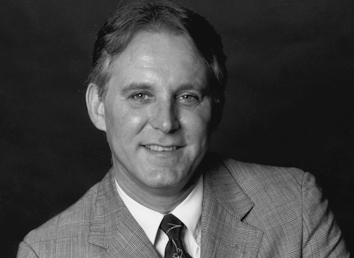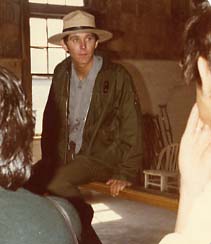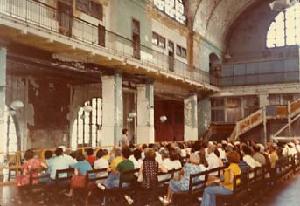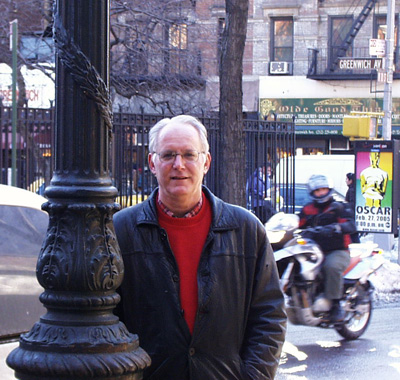.jpg)
ELLIS ISLAND TOURS
Retracing the Steps of our Immigrant Ancestors
| Home |
| Booking a Tour |
| Slide Lecture |
| Reviews |
| Photos |
| FAQ |
| Links |
| Special: Ellis Island 1978-1980 |
| About Tom Bernardin |
There are tour guides, and there are Tour Guides
 Tom Bernardin started work for the National Park Service in 1978 when he
was hired as an interpretive historian, a formal title for the
well-trained federal tour guides at the newly opened (1976) historic
site of Ellis Island. Unlike today's view behind Ellis Island of a shoreline park
along the
uncluttered Jersey City shoreline, Ellis in 1978 was surrounded by the
gritty industrial activity of a part of the harbor that was in decline.
Rangers could boast of some electric lights on the tour route and of a
total of six flush toilets on the island, and tours moved through
walkways framed above with heavy plywood to protect visitors from
falling plaster. All public visits were restricted to guided tours for
safety reasons.
Tom Bernardin started work for the National Park Service in 1978 when he
was hired as an interpretive historian, a formal title for the
well-trained federal tour guides at the newly opened (1976) historic
site of Ellis Island. Unlike today's view behind Ellis Island of a shoreline park
along the
uncluttered Jersey City shoreline, Ellis in 1978 was surrounded by the
gritty industrial activity of a part of the harbor that was in decline.
Rangers could boast of some electric lights on the tour route and of a
total of six flush toilets on the island, and tours moved through
walkways framed above with heavy plywood to protect visitors from
falling plaster. All public visits were restricted to guided tours for
safety reasons.
 The island had no exhibits, films, displays, dioramas, gift shops or
food available on the island. The rangers were the whole show--they were
master storytellers, greeting each tour at the ferry slip and guiding
visitors through the original part of the island for an hour and a half,
describing the immigration process and answering questions. They also
asked questions of their own, querying former immigrants and their
families about their experiences. An accumulation of these stories added
layers of complexity to each ranger's tours that one cannot find in
today's static displays. Those of us who can compare the old Ellis tours
and present-day Ellis still miss the richness of the earliest tours,
before the island was restored.
The island had no exhibits, films, displays, dioramas, gift shops or
food available on the island. The rangers were the whole show--they were
master storytellers, greeting each tour at the ferry slip and guiding
visitors through the original part of the island for an hour and a half,
describing the immigration process and answering questions. They also
asked questions of their own, querying former immigrants and their
families about their experiences. An accumulation of these stories added
layers of complexity to each ranger's tours that one cannot find in
today's static displays. Those of us who can compare the old Ellis tours
and present-day Ellis still miss the richness of the earliest tours,
before the island was restored.
 The tour season before restoration was limited by the weather, when
travel to unheated buildings was tolerable--about six months a year.
While many seasonal rangers moved on into full-time career positions
elsewhere, Tom preferred to work at Ellis for the months he could and do
something else the rest of the year, such as offering slide lectures
about the island. His interest in this story of immigration inspired him
to run a nationwide search to solicit recipes from the families of
immigrants who passed through Ellis Island. These were published in
The Ellis Island Immigrant Cookbook.
The tour season before restoration was limited by the weather, when
travel to unheated buildings was tolerable--about six months a year.
While many seasonal rangers moved on into full-time career positions
elsewhere, Tom preferred to work at Ellis for the months he could and do
something else the rest of the year, such as offering slide lectures
about the island. His interest in this story of immigration inspired him
to run a nationwide search to solicit recipes from the families of
immigrants who passed through Ellis Island. These were published in
The Ellis Island Immigrant Cookbook.
The following is his introduction to the cookbook. A passion for history and a love affair with the Statue of Liberty started it all. . .
|
In
1972, on a very serendipitous and rainy November Saturday
shortly after I arrived in New York, I found myself on a
walking tour of cast-iron architecture given by a most
remarkable woman, Margot Gayle. There, squeezed into a
doorway on lower Broadway, I heard the history of New York
unfold through its rich architectural heritage. She spoke so
enthusiastically of the city’s growth and history that as
the gray day turned into a darker evening, I felt as if! had
been transported to nineteenth-century New York. The
cast-iron buildings, lampposts, and street clocks were from
another world. She easily knew the importance of preserving
our past and was most anxious for us to understand. I then
joined Margot’s organization, the Friends Of Cast-iron
Architecture. My membership card arrived attached to a small
magnet to use in testing a building to see if it was made of
iron. I was hooked! |
 Today,
when he isn't lecturing, writing, or touring around Ellis and Lower
Manhattan, one can find Bernardin working on many historic preservation
projects, such as raising funds to purchase and install historic
replica lampposts in New York City neighborhoods.
Today,
when he isn't lecturing, writing, or touring around Ellis and Lower
Manhattan, one can find Bernardin working on many historic preservation
projects, such as raising funds to purchase and install historic
replica lampposts in New York City neighborhoods.
Tom Bernardin
Post Office Box 1267
Old Chelsea Station
New York, NY 10113
(212)229-0202
Email: ellisbook@aol.com